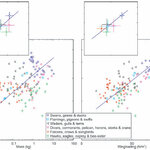Ecology & Zoology

Researchers at the University of Warwick are co-ordinating a global effort to sequence the genome of one of the World’s most important mushrooms - Agaricus bisporus. The secrets of its genetic make up could assist the creation of biofuels, support the effort to manage global carbon, and help remove heavy metals from contaminated soils.
The Agaricus mushroom family are highly efficient ‘secondary decomposers’ of plant material such as leaves and litter –breaking down the material that is too tough for other fungi and bacteria to handle. How exactly it does this, particularly how it degrades…

You're thinking flying speed is just size and strength. Not so, say researchers from the University of Lund in Sweden. It's also a behavior issue and it's related to evolution.
Aerodynamic scaling rules that explain how flight varies according to weight and wing loading have been used to compare general speeds of a wide range of flyers, from the smallest insects to the largest aircraft but Thomas Alerstam, Mikael Rosen and colleagues analyzed the flight speeds of 138 bird species and overturn the general assumption that maximum flight speed of a species is solely determined by such rules.…

Who knew the cute koala bears were so promiscuous?
Professor Peter Timms from QUT's Institute of Health and Biomedical Innovation said chlamydia in koalas was a significant cause of infertility, urinary tract infections, and inflammation in the lining of the eye that often led to blindness.
"The numbers of koalas with chlamydia seems to be increasing," he said.
The first Australian trials of a vaccine developed by Queensland University of Technology that could save Australia's iconic koala from contracting chlamydia are planned to begin later this year.
"The trial is planned to begin before…

Brightly colored birds are among the species most adversely affected by the high levels of radiation around the Chernobyl nuclear plant, ecologists have discovered. The findings help explain why some species are harder hit by ionising radiation than others.
Dr Anders Møller of the Université Pierre et Marie Curie and Professor Timothy Mousseau of the University of South Carolina examined 1,570 birds from 57 different species in the forests around Chernobyl at varying distances from the reactor. They found that populations of four groups of birds - those whose red, yellow and orange plumage is…

First the obesity problem in humans alarmed physicians and then veterinarians worried about fat cags ( and dogs) but now a team of researchers in the Virginia-Maryland Regional College of Veterinary Medicine and Virginia Tech has determined that horses are also facing serious health risks because of obesity.
Fifty-one percent of the horses evaluated during the pioneering research were determined to be overweight or obese – and may be subject to serious health problems like laminitis and hyperinsulinemia. And just like people, it appears as though the culprits are over-eating and lack of…

Unlike moths and butterflies that are often brilliantly colored to warn potential predators that they carry toxins, flowers and the fruits they produce have brilliant colors to attract the attention of pollinators and frugivores who will disperse their pollen and seed, thus guaranteeing the next generation.
The appearance of flowering plants on earth about 150 million years ago had a profound effect on the evolution of many other kinds of organisms like insects, birds, and mammals, who became the pollinators and consumers of those plants, thus ensuring the continuity of both the plant and…

Most plants and animals show changes in activity over a 24-hour cycle. Now, for the first time, researchers have shown how a plant combines signals from its internal clock with those from the environment to show a daily rhythm of growth.
Using time-lapse photography, postdoctoral researcher Kazunari Nozue, with colleagues from UC Davis and the University of Lausanne, Switzerland, found that the shoots of Arabidopsis seedlings show a spurt of growth once a day.
The timing of that growth spurt is controlled by both the plant's internal clock and by exposure to light, acting on two genes called…

At the annual meeting of the American Society of Plant Biologists in Chicago, Dr. Jorge Zavala, Sr. of the Institute for Genomic Biology at the University of Illinois, and colleagues showed that elevated CO2 may negatively impact the relationship between some plants and insects.
Elevated CO2 is considered to be a serious catalyst of global change. Its effects can be felt throughout the ecosystem, including the insect-plant food chain link. Safeguarding highly-usable crops is of great importance to many local and national economies.
Many plants have inherent enzyme-based defenses that are…

An international working group under the direction of Wolfgang und Roswitha Wiltschko of Frankfurt University has now succeeded in demonstrating the presence of a magnetic sense of direction in domestic chickens.
40 years ago, Prof. Dr. Wolfgang Wiltschko was the first to prove that migrating robins use the Earth’s magnetic field to direct themselves during migration.
Their magnetic sensor showed them the course of the field lines of the Earth’s magnetic field. This produces an inclination compass that reacts to the inclination of the Earth’s magnetic field to the surface of the Earth, thus…

Seriously. Except this global warming was emerging from an Ice Age.
The ancient gray wolves of Alaska became extinct some 12,000 years ago, and the wolves in Alaska today are not their descendents but a different subspecies, an international team of scientists reports in the July 3 print edition of the journal Current Biology.
The saber-toothed cat and other large mammals became extinct about 10,000 to 11,000 years ago when their prey disappeared due to factors that included human hunting and dramatic global warming at the end of the Pleistocene, Van Valkenburgh said.
Prior to the new…